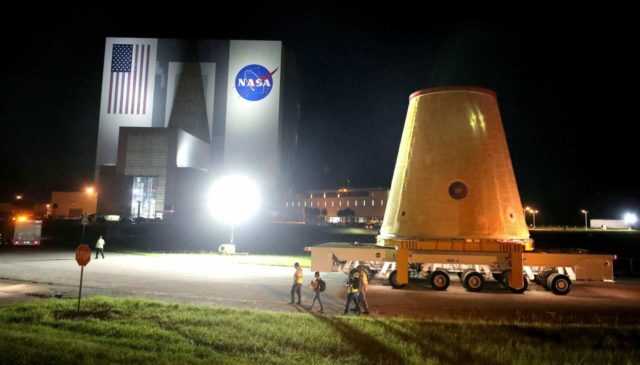
Another delay for Artemis I test rollout pushes moon mission to at least April A piece of the Artemis 1 rocket is transported at Kennedy Space Center, Fla., before sunrise Thursday, July 30, 2020, after making a 13-day journey on a barge from NASA’s Marshall Space Flight Center in Huntsville, Ala. The section is a stage adapter for NASA’s massive Space Launch System (SLS) rocket, which is under development for crewed lunar flights in the Artemis mission, with future plans for possible human missions to Mars. The Artemis 1 launch is currently scheduled for November, 2021. (Joe Burbank/Orlando Sentinel)
NASA announced today it has pushed a planned mid-February rollout of the Artemis I rocket to the launch pad to no earlier than March, meaning a potential launch won’t happen until at least April.
The Space Launch System rocket topped with the Orion spacecraft is slated to roll out on the mobile launcher from the Vehicle Assembly Building at Kennedy Space Center to Launch Pad 39-B so it can go through a test during which NASA fills and drains the core stage with 730,000 gallons of super-cooled liquid hydrogen and liquid oxygen while simulating a countdown, but without lighting the engines.
After that test, the 322-foot-tall rocket will be rolled back the 4.2 miles to the VAB for analysis, and if everything goes well, NASA will then target a return to the launch pad for liftoff.
“There’s no one specific thing. We just have a lot of things that we need to close out. It’s a big vehicle. It’s a lot of instrumentation that needs to be finished and prepared for the final closeout activity,” said Tom Whitmeyer, NASA’s Deputy Associate Administrator of the Exploration Systems Development Division. “It’s really what I would call kind of a punchlist of whole bunch of things that we absolutely need to finish up and then we ‘ll be ready to roll the vehicle out.”
Whitmeyer said the rollout could be in mid-March, but didn’t want to nail down a specific date until teams are closer to a final closeout. The testing will take about two weeks.
“We really don’t know until we do the wet dress rehearsal how much additional time it will take to get ready to launch,” Whitmeyer said. “We hope it won’t be a significant amount of time but really the purpose of the wet dress rehearsal is to see how the vehicle performs in an integrated fashion … I just want to be clear that we we really want to see the results of that test before we can kind of be able to really predict with a good amount of confidence the period of time before we launch.”
With a March launch out the window, the next opportunities NASA is looking at are from April 8-23 and May 7-21. If it delays further, the next windows are June 6-16 and June 29-July 12.
After the SLS arrived to KSC in early 2021, the timeline was targeting a potential liftoff before the end of the year, but engineers had to change out parts to one of the engine controllers, which pushed the first Artemis flight into 2022. The latest delay isn’t for any major issue, just a lot of them.
“We’re taking one step at a time. It’s a first flow, and it’s a first flow of a multi-decade program to get us back to the moon, first woman and first person of color, and ultimately to go onto Mars and explore the solar system.” said Mike Bolger, NASA’s program manager for Exploration Ground Systems based at Kennedy. “We’re doing it very meticulously and we’re proud of the progress that we’ve made.”
Bolger said teams had recently completed several integrated tests, the power up of both SLS and Orion, checking umbilical systems, the countdown test with flight software and integrated communication systems. This week teams are installing and testing flight termination systems, as in explosives, for the launch vehicle.
Whether it’s as early as April or pushes into summer, depending on the day it launches, the mission could last either four or six weeks. The plan is to send Orion farther into space than any other human-rated spacecraft has ever traveled — 280,000 miles away, which is 40,000 miles beyond the moon.
Artemis I is the first of a series of planned missions to the moon that look to return humans, including the first woman, to the lunar surface for the first time since 1972. When it launches, the SLS rocket will surpass the power of the Saturn V rockets of the Apollo program, producing 8.8 million pounds of thrust at liftoff.
Originally to have launched in 2016, the SLS and Orion hardware have seen numerous cost and production delays, which have had a domino effect on future Artemis missions.
NASA now plans the crewed Artemis II flight, which will take humans in an orbit around the moon without landing, no earlier than May 2024. The Artemis III mission, which would use a Human Landing System to bring two astronauts to the lunar surface, is now planned for no earlier than 2025.
“When the vehicle’s ready and the agency accepts the risk associated with proceeding with flight, the ball will pass to myself as well as the operations team to go out and execute Artemis I, this uncrewed flight test, that will thoroughly shake down the Space Launch System rocket,” said Artemis Mission manager Michael Sarafin. “I can say with confidence at this point we are on track and will be ready when the hardware is ready to fly.”
___
© 2022 Orlando Sentinel
Distributed by Tribune Content Agency, LLC.




